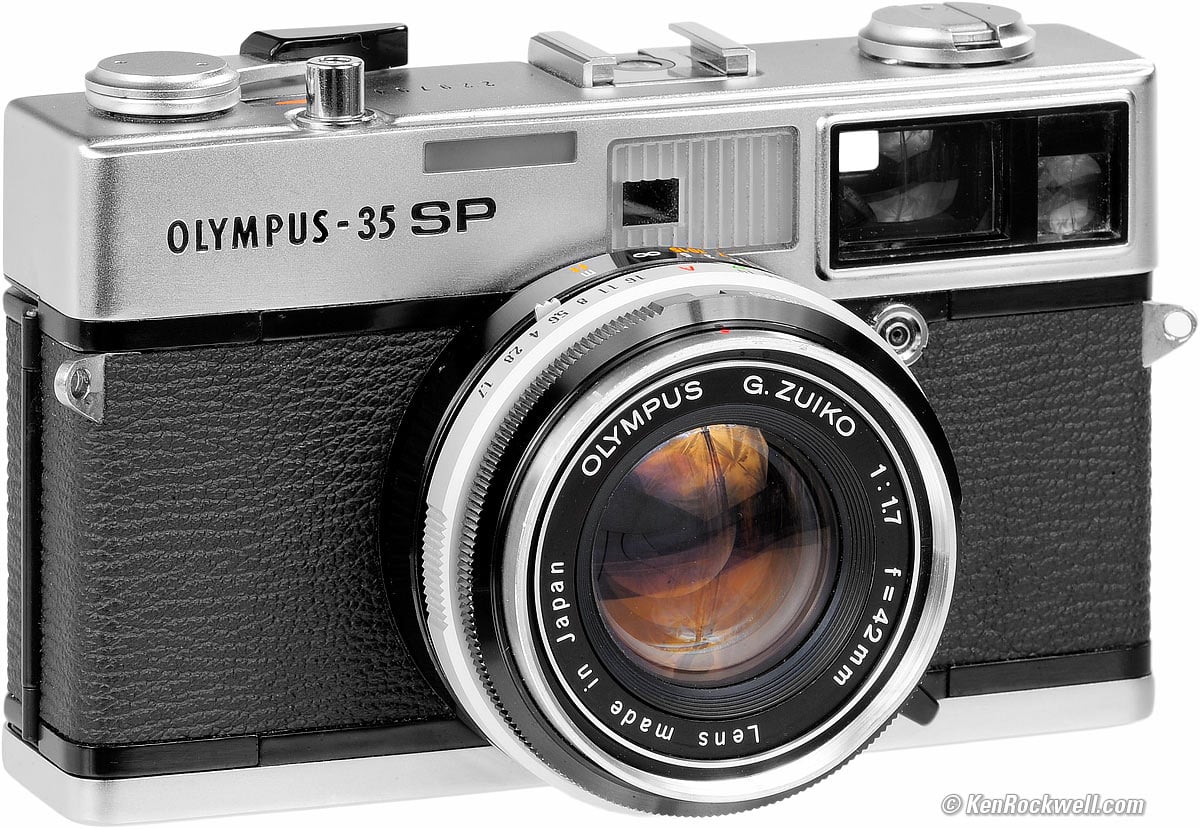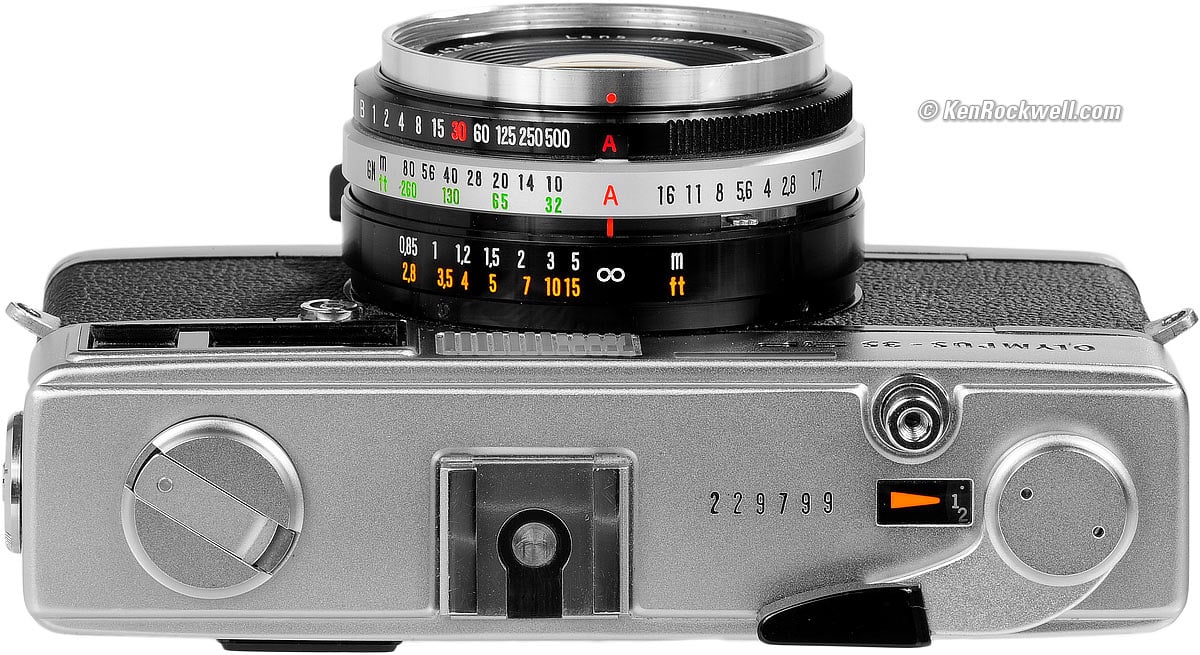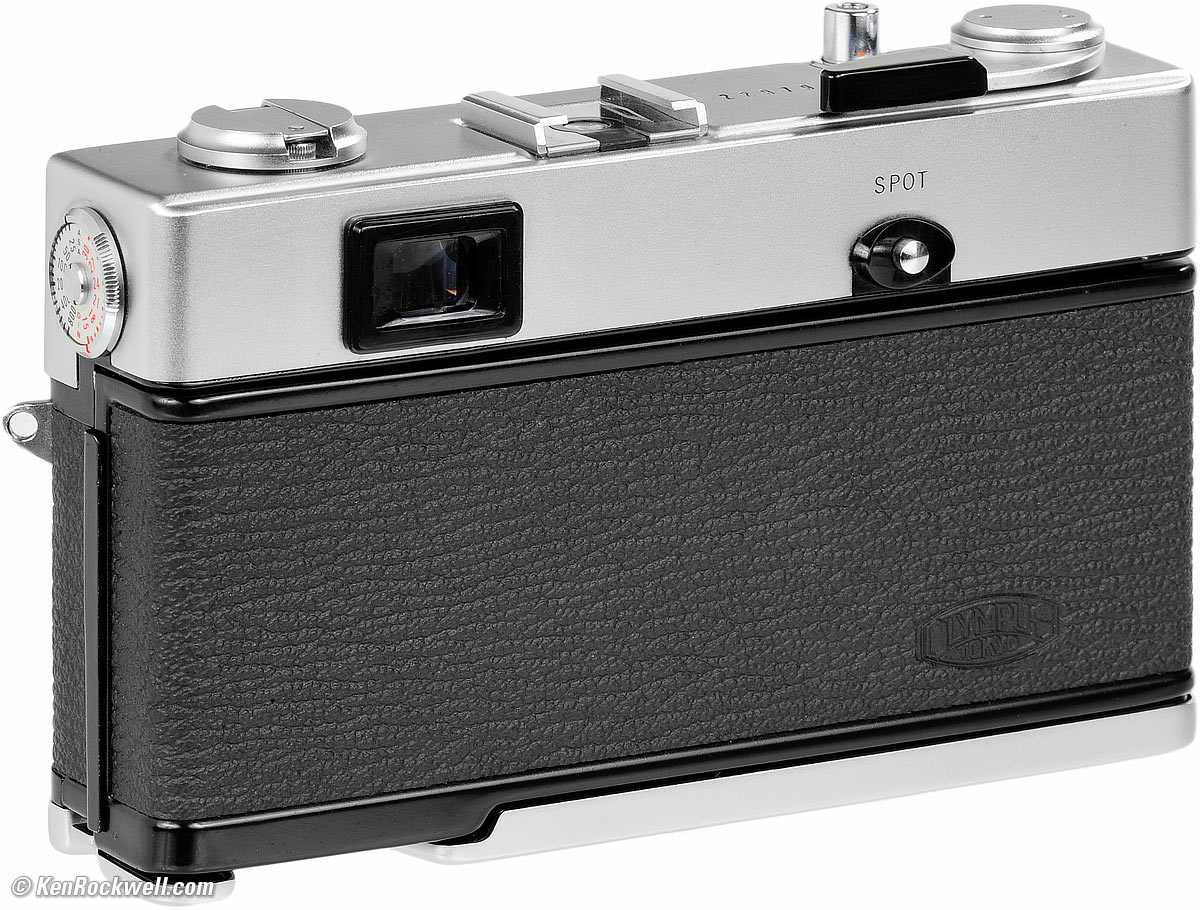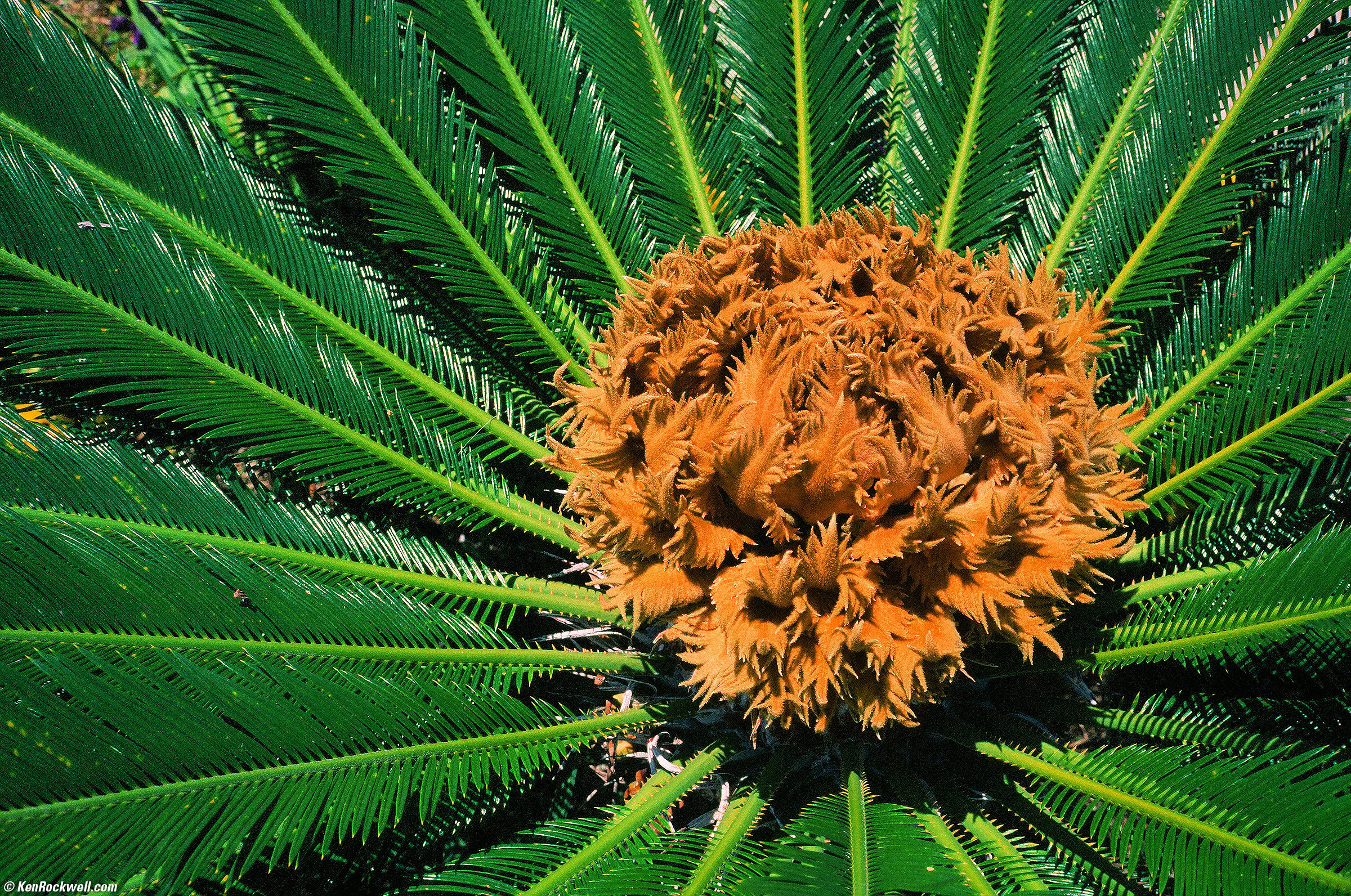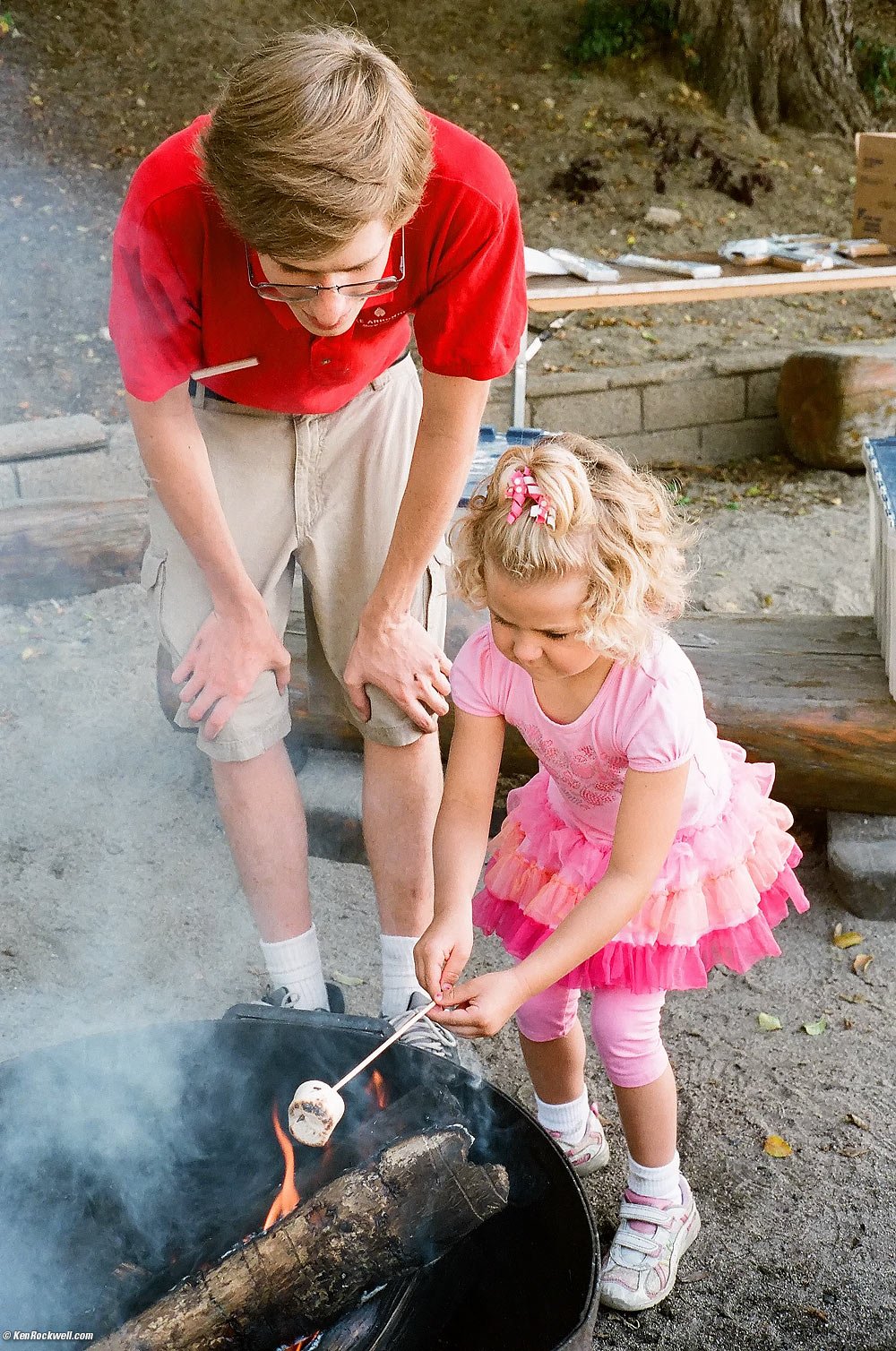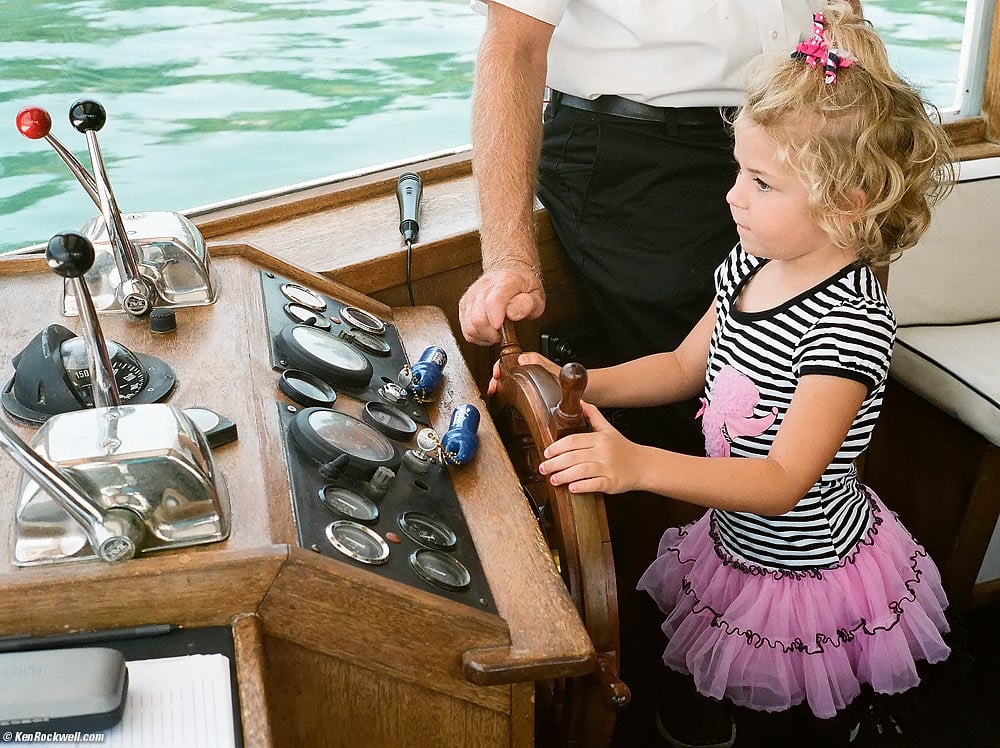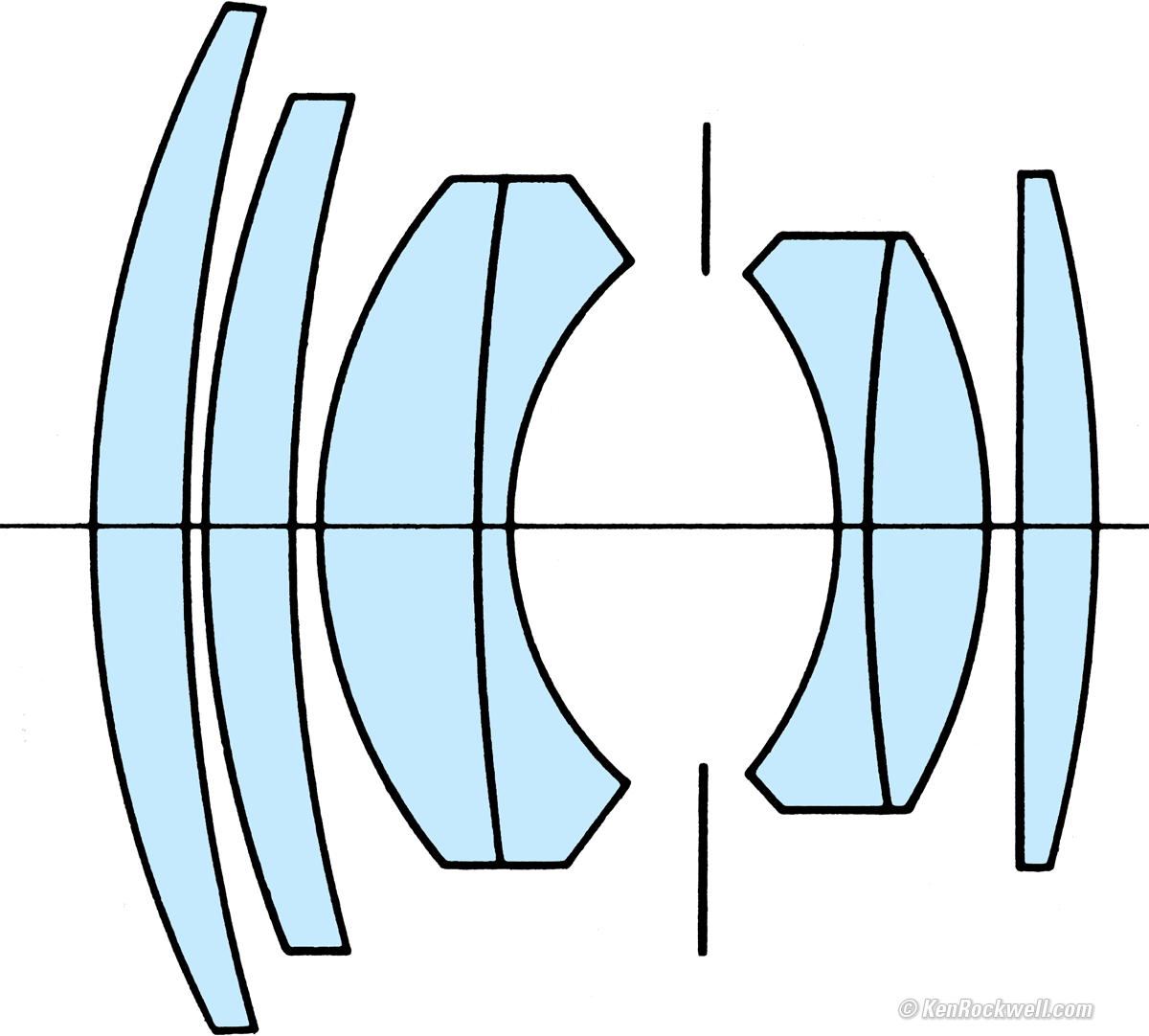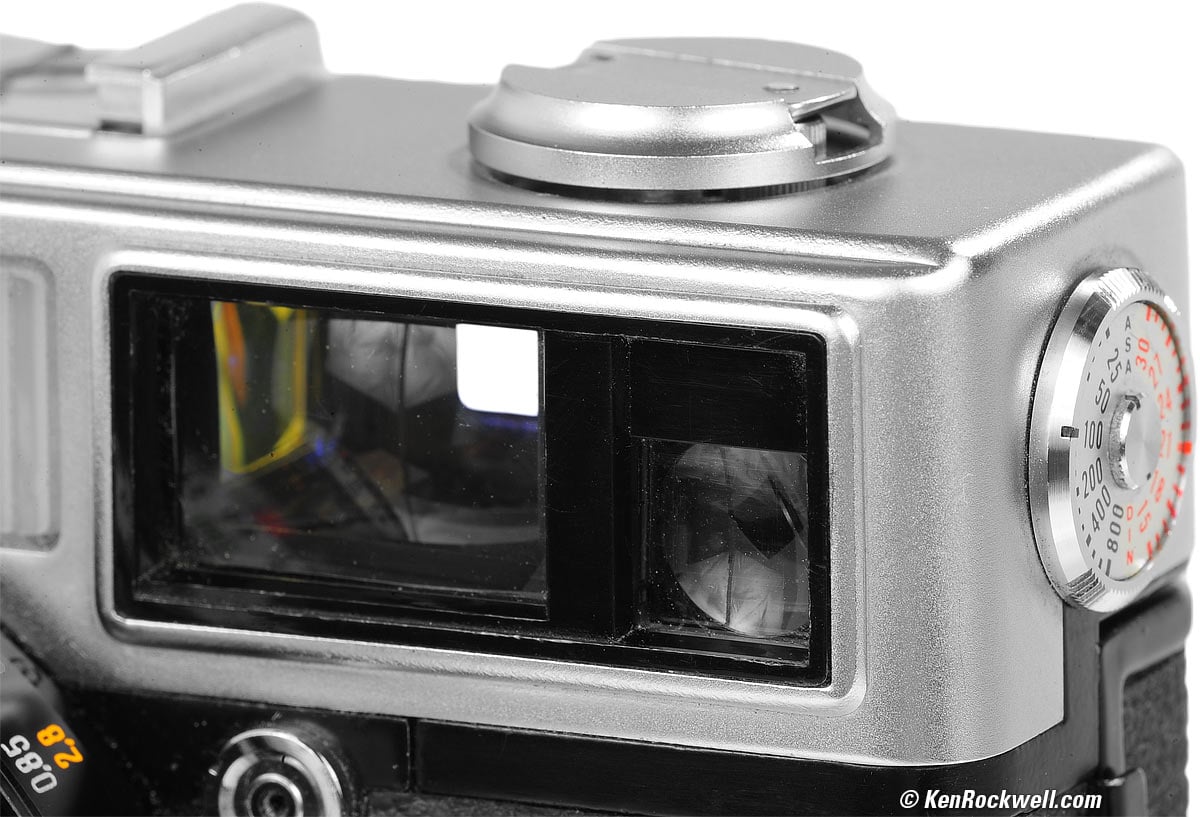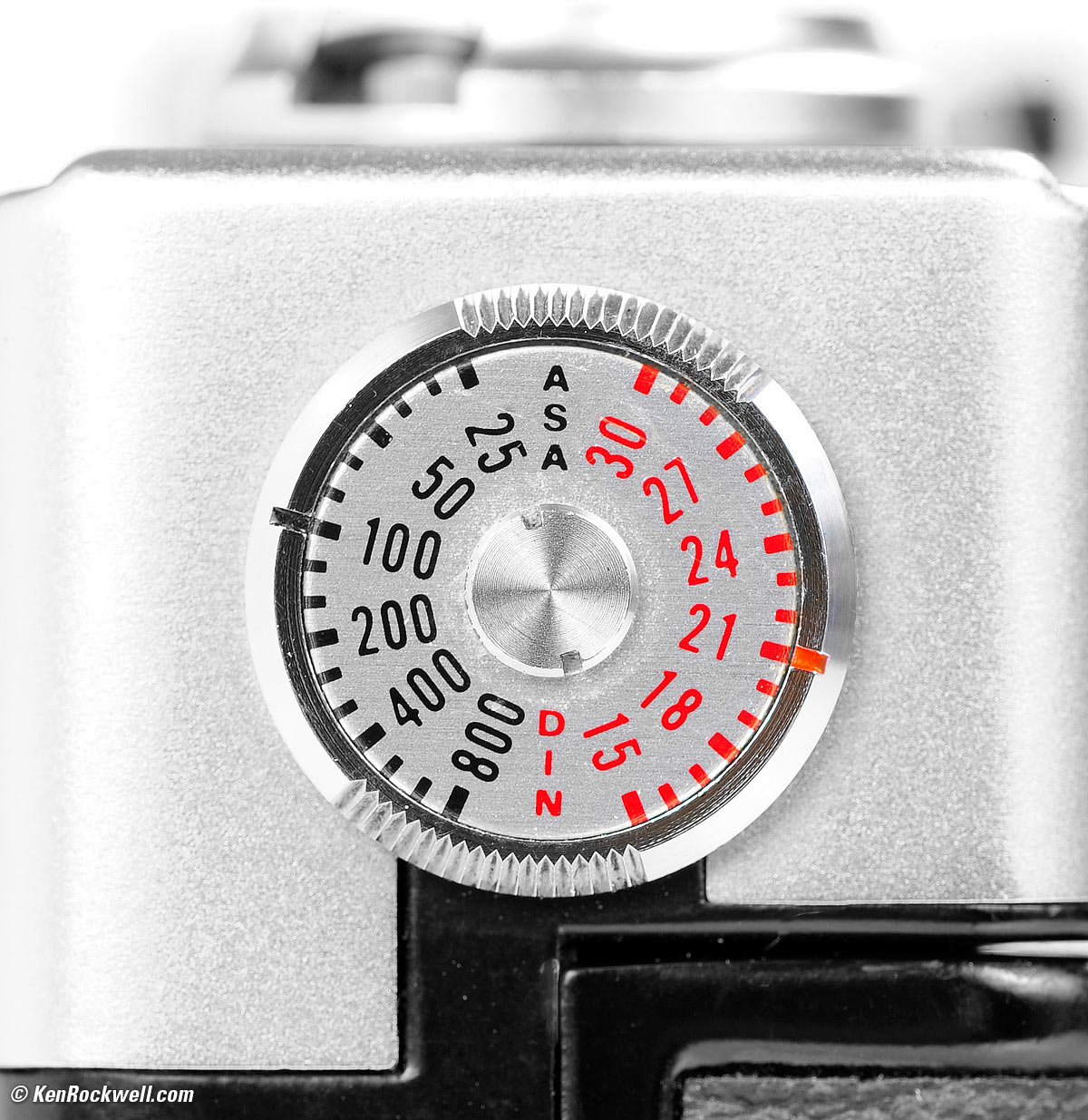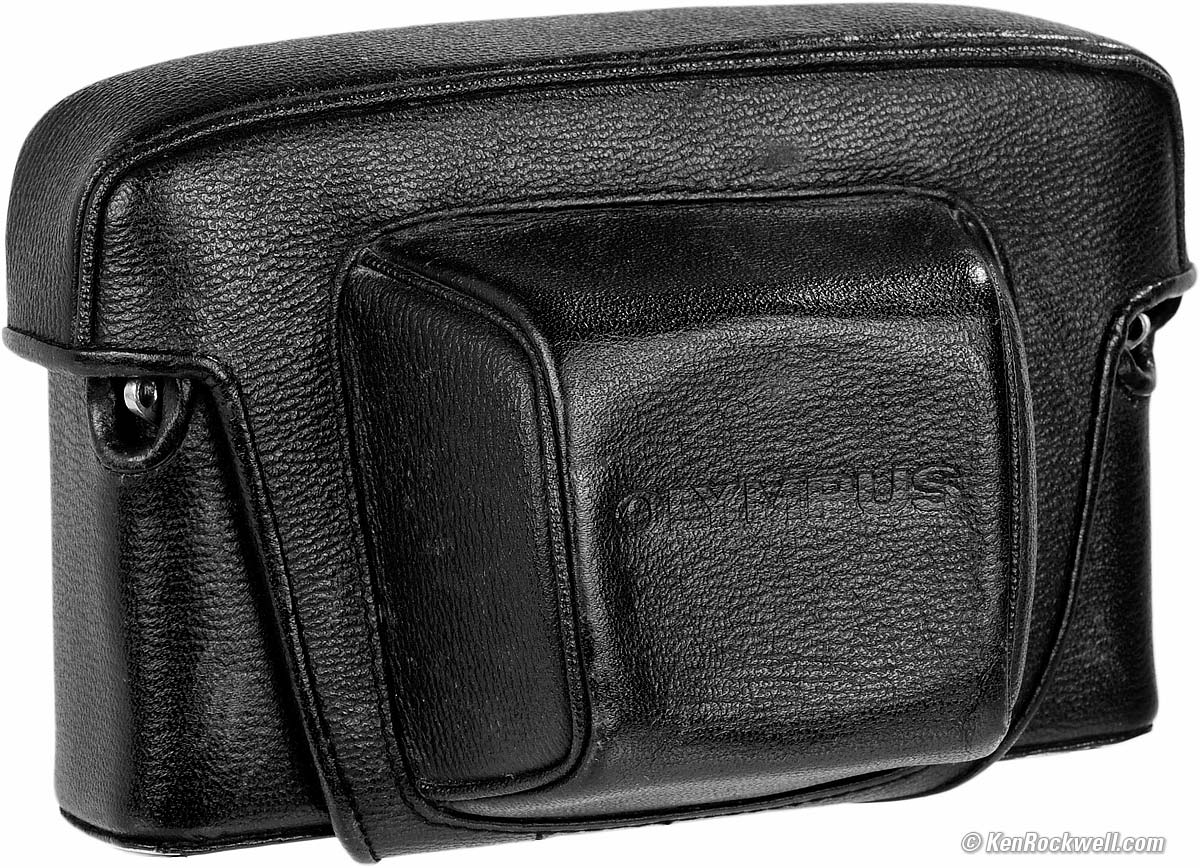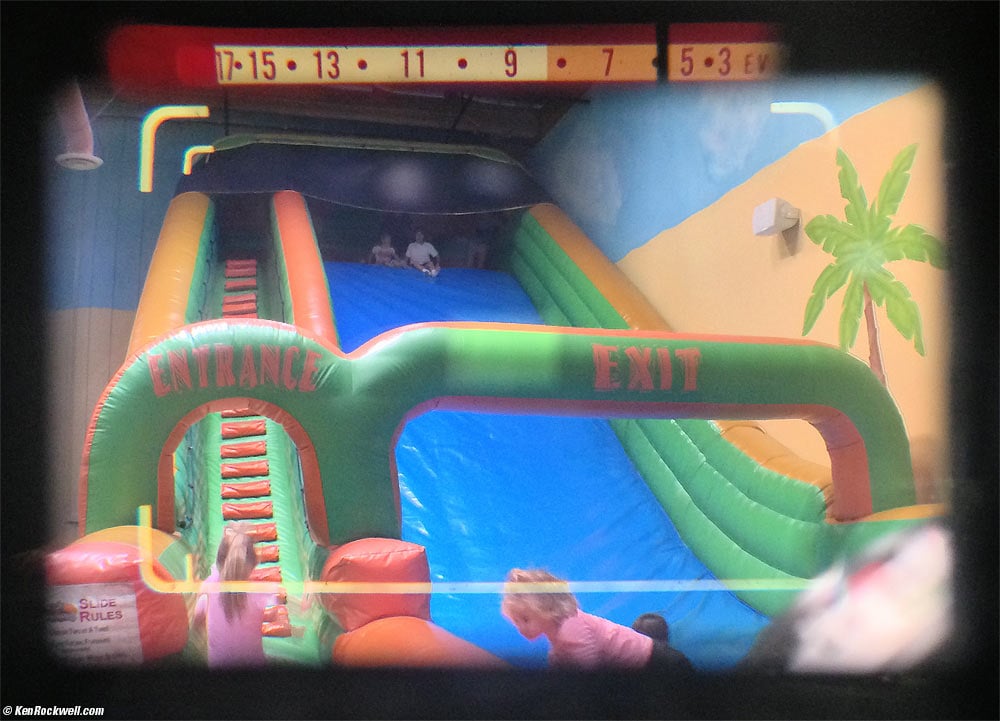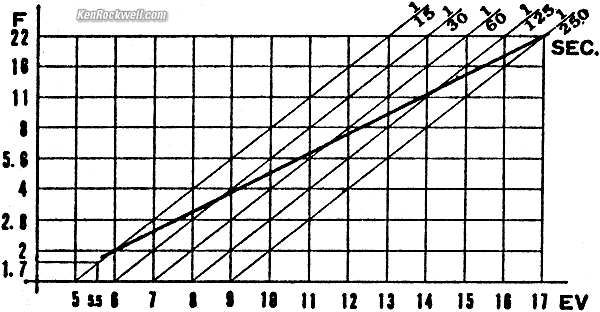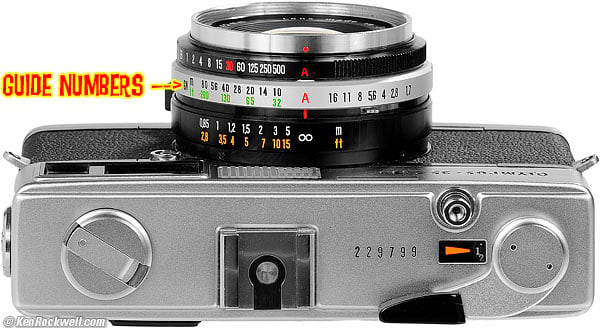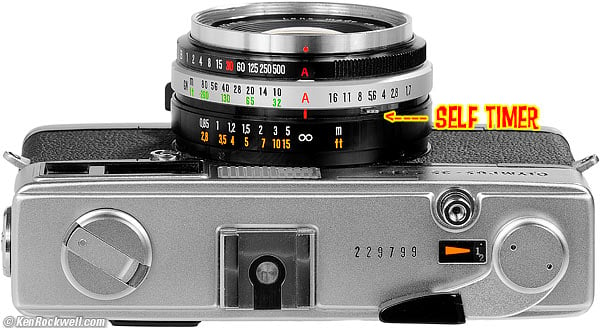Olympus 35SP
7-element 42mm f/1.7 lens (1969-1975)
Intro Specs Performance Compared Usage Recommendations More
Olympus 35 SP (EPX-625 battery for meter, metal 49mm filter thread, 21.2 oz. / 600g with film and battery, 2.8'/0.85 m close focus, about $200 used if you know How to Win at eBay; I paid only $80 for this one in 2013). enlarge. I'd get it at this link directly to them at eBay (see How to Win at eBay).
This all-content, junk-free website's biggest source of support is when you use those or any of these links to approved sources when you get anything, regardless of the country in which you live. Thanks for helping me help you! Ken.
February 2020 Olympus LEICA Fuji Zeiss Nikon Canon All Reviews
Why Fixed Lenses Take Better Pictures
How to shoot the 35 SP digitally
I've been getting my film directly from B&H and Adorama since the 1970s; you've never been able to get professional film at local retail stores. I use NCPS or Costco to process and scan all my film. If you're reading this, you have a mailbox and can get all the film and processing you need; B&H and Adorama ship worldwide, and NCPS does mail-order work from around the world every day.
Top, Olympus 35 SP. enlarge.
Rear, Olympus 35 SP. Note SPOT meter button. enlarge.
Sample Images
Sago Palm, 04 July 2013. Fuji Velvia 50, EV 13 (about 1/100 at f/9), 0.93 meters focus distance, NCPS process and scan, Perfectly Clear. bigger. Are your photos as sharp? Maybe it's time to dump digital and get back into real photography!
The Official Camera of Summer Vacation!
Katie and Ryan on the beach at Lake Arrowhead, 6:45 PM, 22 July 2013. (Olympus 35 SP, Fuji Pro 400H, NCPS process and scan, Athentech Perfectly Clear plug-in.) Bigger.
Katie making s'mores at Lake Arrowhead, 6:20 PM, 22 July 2013. (Olympus 35 SP, Program mode set EV 12 (about 1/60 at f/8), Fuji Pro 400H, NCPS process and scan, Athentech Perfectly Clear plug-in.) Bigger.
Katie Pilots the Lake Arrowhead Queen, 12:50 PM, 23 July 2013. (Olympus 35 SP, Fuji Pro 400H, NCPS process and scan, Athentech Perfectly Clear plug-in.) Bigger.
Good
Small and light camera with a superb 7-element high-speed "perfect normal" 42mm f/1.7 lens.
This rangefinder 42mm f/1.7 lens is sharper than SLR lenses!
Super fast and easy focus; faster and easier than a LEICA.
Full program auto exposure — just focus and shoot!, or metered manual.
Flashmatic guide-number automatic flash exposure: just focus, and the 35 SP sets the aperture automatically for perfect flash exposure.
The battery only runs the meter; everything else, even automatic flash exposure, works mechanically.
The meter is always on, no wasted time looking for the switch.
Wide-range meter covers all light levels without needing a range switch.
In-finder light meter read-out.
Spot meter at the press of a button, otherwise center-weighted.
Exposure locks as shutter pressed halfway.
Focus lever for fast focusing!
Bad
Full in-finder exposure meter readout, but no in-finder indication of exposure mode. If you set the camera to manual, you might not realize you're not on AUTO until you look at the lens again.
Fluff
Nothing!
Everything on this camera serves a real purpose.
Missing
No cocked indicator - LEICA don't have these either.
No meter scale illuminator - LEICAMETERs don't have these either.
No depth of field scale.
No automatic parallax compensation, but does have manual compensation marks. These marks do however compensate for the reduced angle of view at close distances, which LEICA does not.
Extra Features
Spot meter at the push of a button!
Introduction top
Intro Specs Performance Compared Usage Recommendations More
|
I buy only from these approved sources. I can't vouch for ads below. |
The Olympus 35 SP is a fixed-lens mechanical rangefinder camera with a leaf shutter and completely automated program autoexposure, as well as full manual exposure controls and a dual spot and center-weighted meter.
The 35 SP is the best fixed-lens rangefinder camera of all time.
My photos from it are always sharp and well exposed, and it's always ON: there is no need for a power switch. Even at 1/15 of a second, hand-held shots are super-sharp thanks to its smooth trigger pull and quiet leaf shutter.
The Olympus 35 SP just shoots. It looks good, feels good and sounds good — all with a super-fast and sharp f/1.7 lens. With its fully automated Program mode exposure as well as fully metered manual — and a focus tab that flicks instantly with a fingertip — the 35 SP is easy to shoot fast and accurately.
The Olympus 35 SP stands out for its superb, fast lens and fully automated mechanical program exposure, along with a spot meter and full manual controls.
The 35 SP has "Vacation!" written all over it. I can't think of a better camera for vacations and family fun. The Fuji X100S is the closest imitation in digital, but the 35 SP is always ON and ready to shoot with zero delay, and you never have to charge its battery. Who wants to go on vacation and have to remember to bring a battery charger and charge batteries — and miss shots waiting for a digital camera to turn on and decide to focus?
The 35 SP runs on a mercury PX-625 or PX-13 cell for years at a time. Today, use the Wein EPX-625, or the PaulBG adapter with any 675 Zinc-Air hearing-aid cell available everywhere (I pay $8.99 for forty at Costco!).
At 600 grams (21.7 oz.) fully loaded with lens, film and batteries, it's big enough to have every feature one needs, and small enough to take everywhere.
The Olympus 35 SP is the best camera ever made by Olympus for serious photography. While the newer Olympus XA series is smaller and even more convenient, for the photographer who knows what he's doing and demands a camera with better reliability and better and faster handling than even anything from LEICA, the Olympus 35 SP is the answer.
The 35 SP's 42mm lens is the "perfect normal," equal to the usable diagonal of the image, the definition of a normal lens. While 50mm lenses are often a little too long and 35mm lenses are often a little too wide, with the 42mm Perfect Normal, one never needs to swap lenses. With a 42mm lens, you've got the perfect lens for everything, all the time.
Likewise, the f/1.7 speed is perfect. It's about as fast as the SUMMILUX, and about as sharp as the SUMMICRON. Some call this lens the SUMMILUXICRON, offering essentially the speed of the SUMMILUX and the sharpness of the SUMMICRON, all in one lens. LEICA has never made such a lens; the closest LEICA has come is the 40mm f/2 SUMMICRON-C which is a simpler lens, and doesn't work properly on any LEICA except the CL and CLE which have framelines for a 40mm lens.
While with LEICA lenses you need to carry at least four lenses: a 35mm f/1.4 SUMMILUX, a 50mm f/2 SUMMICRON, a 35mm f/2 SUMICRON and a 50mm f/1.4 SUMMILUX, you get all four lenses in the one G. Zuiko 42mm f/1.7. 42mm is also exactly in between 35mm and 50mm, and f/1.7 is exactly in-between f/1.4 and f/2. While every other camera makes forces you to buy four lenses, none of which really hits the mark, BINGO!, this Olympus provides you with a lens that replaces all four other lenses. While the LEICAMAN is fumbling with his impressive lens collection, you've already got the shot.
The meter is always on — there is no need for a switch. It turns itself off automatically in the dark or in its case. The meter reads directly in EV in the finder, which is set directly on the aperture and shutter rings. The EV system makes it trivially easy to use the SP as a meter for another camera with EV markings, or use another meter with the SP.
Personal History
My dad bought one of these for my mom back when I was a kid as the family's "good" camera. My dad taped a note on the back of her flash that said "• A A I" for outdoors (program auto) or "• 30 dash I" for automatic guide-number calculating flash indoors, and my mom easily could focus and snap all the photos of our family growing up.
Of course dad bought a 35 SP instead of an SLR for my mom; there was no such thing as a fully automatic exposure SLR in those days, and the rangefinder 35 SP weighs so much less than an SLR — and has a much better lens, too!
Versions and History
1965-1967: 35 LE (not reviewed here)
The earliest Olympus 35 LE uses the same lens, and featured 6 transistors!
Its Seiko-ES electronic shutter operated automatically from 1/25 to 1/500 second, and worked only in its programmed automatic mode — or Flashmatic for flash.
1967-1969:35 LC (not reviewed here)
The Olympus 35 LC uses the same lens, but lacks the Program mode.
Instead, it has a coupled manual meter and manual exposure.
1969-1972: 35 SP ("spot meter")
Chrome camera as reviewed here, the most common version. It offers program and full manual exposure controls.
There were some made in black, but few people wanted them so there weren't many sold. They are easy to find on eBay in any color.
1972-1974: 35 SPn ("newer SP")
The Olympus 35 SPn is the same thing in chrome, with an uglier black aperture ring, ugly "black-eye" trim around the finder and add a battery-check light. These are less common.
1973: 35 UC ("ugly camera")
The 35 UC is an even uglier version of the SPn with a black insert covering most of the front chrome.
It's still the same 35 SP underneath.
1975: 35 RD (not reviewed here)
The 35 RD is a completely different and cheaper camera. Yes, it has a 42mm f/1.7 lens, but it's a simpler 6-element (F. Zuiko) design.
Production Totals
I see serial numbers as low as 100,000 and as high as the low 300,000s, suggesting that Olympus made at least a quarter-million original 35SPs from 1969-1972.
Groovy, Baby!
The 35 SP isn't shy about its use of fluorescent paint for various markings.
As seen under black light common at 1960s parties, many of the markings glow out loud!
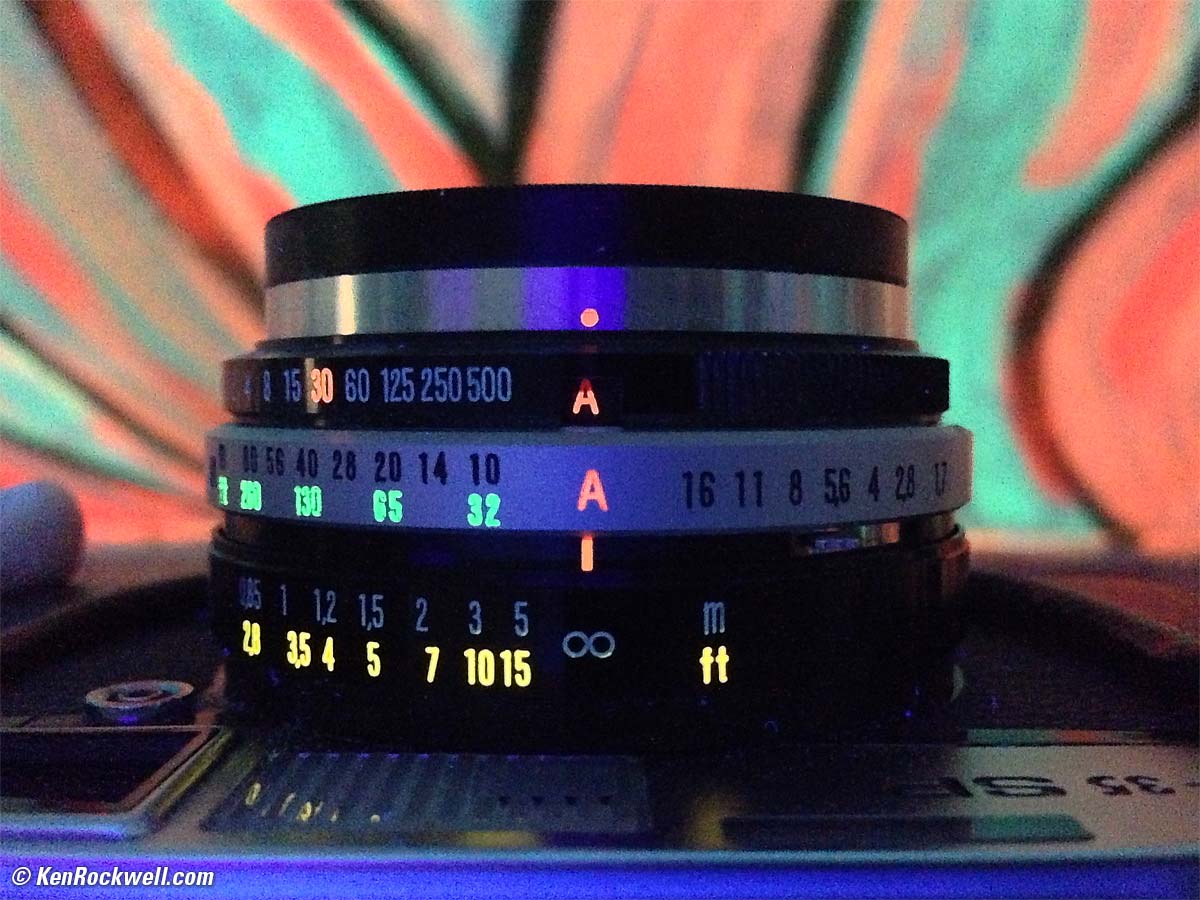
Olympus 35 SP Groovy Colors.
Specifications top
Intro Specs Performance Compared Usage Recommendations More
Lens
G. Zuiko 42mm f/1.7 "SUMMILUXICRON."
Olympus G. Zuiko 42mm f/1.7 diagram. bigger.
Optics
7 elements in 5 groups.
Highly optimized double-Gauss, similar to the LEICA SUMMILUX 50mm f/1.4.
Filter Thread
49mm, metal.
Closest Focus
0.85 meters (2.8 feet).
Diaphragm
5 straight diaphragm blades.
Stops down to f/16 manually or to f/22 in its auto modes.
Angle of View
54.5° diagonal angle of view.
31.9° vertical angle of view.
46.4° horizontal angle of view.
Sensor
Standard 35mm film.
Full-frame 24 x 36mm image area.
I've been getting my film directly from B&H and Adorama ever since the 1970s, and they ship world-wide. I use NCPS to process and scan all my film, and they do mail-order from anyplace on earth daily. If you're reading this, you have a mailbox, and can get all the film and processing you need.
ASA (ISO)
25 ~ 800, set on dial on the top left.
Also DIN 15 ~ 30.
Finder and meter windows, Olympus 35 SP. enlarge. Note diaphragm in front of meter window which adjusts the meter's sensitivity as you set the ASA.
Olympus 35 SP film speed dial.
Viewfinder
0.7x magnification (a little more than the LEICA M9).
Parallax compensation marks (doesn't auto compensate).
Focus and Rangefinder
Traditional superimposed double-image rangefinder with yellow spot.
Single-geared direct-advance helicoid.
31.5mm mechanical base length.
22mm effective base length.
Light Meter
CdS center-weighted or spot — just push the button.
20° or 6º angle of acceptance, similar to a 15mm diameter or 4.4mm diameter circle on your film, or 20% or 1.76% of the total image.
Reads EV 3-17 regardless of ASA setting.
Programmed auto exposure from EV 5.5 - 17 (1/15 at f/1.7 to 1/250 at f/22) regardless of ASA setting.
Set the exposure manually below EV 5.5.
Shutter
SEIKO-FLA 5-blade mechanical leaf shutter.
Programmed EE (electric eye).
1 - 1/500 second and Bulb in manual.
1/15 to 1/250 in AA (Program Auto).
Self Timer
9 seconds, rated.
9.9 seconds, measured.
Cable Release
Standard screw-in cable release.
Flash Sync Speed (maximum shutter speed with flash)
1/500 second.
Flash
X-sync to 1/500 second.
Hot shoe.
PC terminal.
Flashmatic mechanical automatic exposure system: set the Guide Number on the camera, and as you focus, the 35 SP sets the correct aperture, even without batteries!
Flashmatic works with working GN 10-80 meters (32-260 feet), regardless of ASA.
Power
Ideally use a mercury PX-625 or PX-13 like the Mallory RM625R, Eveready E625, GE 625, National M-1D, Toshiba TH-MC or similar. A new one usually lasts 10 to 20 years so long as you close the case or keep the camera in the dark when it's not in use.
Today, it's much easier to find the Wein EPX-625, or use the PaulBG adapter with any 675 Zinc-Air hearing-aid cell. A 675 cell lasts 10 months for me, and I get them in bulk for $10 for 40 at the Costco hearing aid department.
The meter is always on. It turns off automatically in the dark or when the case is closed.
The meter and battery don't care how many photos are taken; the battery only moves the meter needle and your fingers operate the rest of the camera.
Quality
Camera and case both Made in Japan.
Size
5.08 x 3.00 x 2.40 inches WHD.
129 x 76 x 61 mm WHD.
Weight
20.370 oz. (577.5g) with battery.
21.150 oz. (599.6g) with film and battery.
25.145 oz. (712.8g) with case, film and battery.
Olympus rates it at 600g, empty.
Included
Olympus 35 SP case. bigger.
Case.
Optional Accessories
49mm filters.
35SP Lens Hood.
Flash CL (uses AG-1 or AG-3N flashbulbs).
PS100 G Electronic Flash.
Announced
April 1969.
About $200 used in February 2020.
About $150 used in 2014.
About $100 used in 2013.
24,800 Yen list price at introduction in 1969.
Performance top
Intro Specs Performance Compared Usage Recommendations More
Overall
I love my Olympus 35 SP!
It's small, light, easy and fast to use, runs about a year on a single EPX-625 cell, and all my images are sharp, clear and perfectly exposed. What could be better?
My LEICAs cost at least twenty times more, the results from my Olympus are the same, and the 35 SP handles a whole lot faster and easier and weighs much less.
LEICA has no SUMMILUXICRON lens as does the 35 SP; with my LEICAs I never know if I want the sharpness of the SUMMICRON or the speed of the SUMMILUX, or 50mm or 35mm. With the 35 SP, it's 42mm f/1.7 gives me the sharpness of the SUMMICRON with the speed of the SUMMILUX, and the 42mm focal is the prefect normal lens that LEICA doesn't have.
Loading and Winding
It loads and winds like every other 35mm camera.
It's a little faster to load than others because you don't have to pull up the crank; there's a cutout on the bottom so film just pops right in.
Film advance needs a full stroke; you can't use several smaller strokes.
It takes me 32 seconds to load, once the case is off.
I can rewind in 11 seconds, or 22 seconds including unscrewing the case bottom.
Frame Counter
It reads S • • 1 2 • 4 • 6 with even numbers to 36. There is one dot past 36 for 37.
12, 20 and 36 are yellow. (24 is silver like the other numbers.)
Even if you get more frames, the counter stops at the dot for 37.
Film Economy
With Fuji Velvia, I can shoot to what would be frame counter 38, which gets me 39 perfect frames if you shoot frame 0 as I do.
Kodak usually only gives me 38 frames on a roll.
Finder
Katie at Scooter's Jungle, 7 July 2013, as seen through the Olympus 35 SP viewfinder.
The finder has a fixed frame with parallax marks, a rangefinder spot and the light meter reading in EV at the top.
The finder is bright and super contrasty, much better than what's seen above.
It's better than any LEICA because it both shows my photo with no interference from other lens' framelines, and shows the exposure meter reading. Earlier LEICAs don't show the meter reading, newer LEICAs crap-up their finders with frames for lenses not on the camera at the same time. At least the newest LEICAs have a primitive red LED to show shutter speed, but these LEDs often also encroach inside the framelines.
There are separate Illumination windows for the bright lines as well as the meter scale, which runs backwards. The orange zone means the shutter speed is below 1/30, and red means it's going to overexpose.
The 35 SP's finder is as it should be.
Focus
Focus is fast and easy. The rangefinder spot is bright and contrasty, and the lens' focus lever flips back and forth fast and easy.
The lens focuses with a tab. It's smooth and fast, better than LEICA because the tab moves faster and doesn't need to be damped. Maybe this is why the 35 SP outsold LEICA!
The 0.85 meter close-focus stop is perfect for self portraits.
Shutter
The shutter release travel smooth and deep. It's a longer than usual travel because your finger pressure is actuating all the auto exposure internals. The 35 SP uses a "trapped needle" system, where all the power needed comes from your finger.
The battery moves the needle, and as you press the shutter, the needle it trapped (locked), and then other feelers press up against the cams attached to the needle movement that set the shutter and diaphragm, all powered each shot by your long press.
The long pull means there's no need for a safety switch or lock.
It also means you have degrees of commitment as you press it down: you press partway to lock exposure, and then further and further until you know the spot that will be the instant it fires.
With all this going on, the leaf shutter isn't as quiet as you expect, but still quieter than an SLR.
The self timer runs precisely 9.9 seconds. It's the little silver lever on the lens. It only works in Program mode.
I measure these actual speeds on the random sample I bought from a random stranger over eBay:
Set |
Actual |
Error |
1 |
1.085 s |
+0.11 |
2 |
0.55 s(1/1.8) |
+0.14 |
4 |
0.26 s (1/3.8) |
+0.06 |
8 |
0.121 s (1/8.3) |
-0.05 |
15 |
66 ms (1/15) |
+0.08 |
30 |
32.65 ms (1/31) |
+0.06 |
60 |
16.18 ms (1/62) |
-0.05 |
125 |
8.00 ms (1/125) |
+0.03 |
250 |
4.00 ms (1/250) |
+0.03 |
500 |
2.90 ms (1/345) |
+0.57 |
Perfect: It's within a tenth of a stop at all speeds, except for 1/500 which is a half stop slow, exactly as we expect leaf shutters to do. Not bad for a 40 year old camera that has probably never been serviced!
Lens
The lens is perfect. It's the perfect focal length, the perfect speed, and it's tiny, super sharp and has no distortion. Perfection!
This rangefinder-design 42mm f/1.7 lens is sharper than SLR lenses because its rear elements can approach much closer to the film, while SLR lens designs are restricted by having to keep the rear elements clear of the flipping mirror.
Combined with the excellent rangefinder, it's easy to get perfect focus and sharp shots in any light.
It's ideal for intimate portraits in a way no LEICA can imitate; it's just a little wider than 50mm to let us see a little more of the subjects surroundings, and just a little tighter than a 35mm so nothing is distorted. Bravo!
It has the same open aperture diameter as a 35mm f/1.4 or 50mm f/2; this is a very serious lens even if you don't realize that the funny-sounding 42mm focal length just happens to be exactly the diagonal of the printed 35mm frame, which is the definition of what a normal lens is supposed be.
The open aperture of the lens is also the same as the human eyeball's diameter. Coincidence, or intelligent design?
The close-focus distance of 0.85m is perfect; it's always close enough, even for hand-held self portraits. 0.85m is perfect for this, so you can just set it to the stop and snap away.
There isn't much bokeh to be seen since the program favors smaller apertures. There isn't usually anything much out of focus. Bokeh is only so-so when you can see it.
It has no distortion.
Ergonomics
The 35 SP is as it should be. It just goes; its ergonomics are superb!
The bright fluorescent red 30 shutter marking makes it easy to see in the dark, and once you know where 30 is, it's easy to click to the others.
Focus is with a tab for your left hand.
One gotcha is that the strap lugs are too far down, so it flips over even with a tiny flash on top.
Another slight gotcha is that the ASA dial is partly shiny, so it's easier to read in diffuse light, not in direct sunlight. You shouldn't be loading film in direct sunlight, so take it as a hint.
Otherwise, this is a more perfect camera than just about any other 35mm camera, ever.
Meter and Exposure
The exposure program favors smaller apertures with slower shutter speeds in bright light (f/11 at 1/125 for instance), ideal for landscapes, and is neutral in dim light (f/2 at 1/15 for example). Therefore it's ideal for people photos in any light, and optimized for landscapes in bright light as well. Bravo!
CdS meter is always accurate. All it does is move the EV needle in the finder. If you've set AA for program auto exposure, your finger pressure locks the needle and makes all the settings mechanically.
Like most CdS meters, it can take a longer time to react and settle at low values like EV 5 and below.
A funny fact is that it's more difficult to read the meter down at EV 3 because everything is so dark!
If it's too bright, the needle pegs in the middle of the red band.
If I have a black item in the middle of a bright field, I get a null of about five stops. This is probably about the same as the lens' own flare, so I wouldn't worry about it.
The meter draws this much current:
EV |
Current Draw |
dark |
0.3 µA |
5 |
30 µA |
6 |
47 µA |
7 |
70 µA |
8 |
95 µA |
9 |
135 µA |
10 |
190 µA |
11 |
200 µA |
12 |
300 µA |
13 |
334 µA |
14 |
378 µA |
15 |
400 µA |
16 |
427 µA |
17 |
442 µA |
Olympus 35 SP Current Draw.
Mechanics
The 35 SP is typical for the era. It's well made and all metal, but not as solid as a LEICA or Nikon of the era. It only cost a fraction as much, too; this was always a consumer camera — or a pro's vacation camera.
I saw a sample once that had the odd problem of making slight double images due to some sort of internal motion at fast shutter speeds.
The only weak point is the black plastic surrounding the spot meter button. In some samples, this plastic deteriorates and disappears.
Film Economy
I get 27 frames on a roll of 24.
I get 39 or 40 frames on a roll of Fuji 36. I tend to get one frame less on Kodak.
Battery and Power
The EPX-625 only moves the meter needle.
No power is needed for film winding, shooting or setting auto exposure. Your fingers do all the work while the battery only needs to move the meter needle.
All other power comes from your thumb (to advance film and cock the shutter) and from your trigger finger as you press the shutter button (to set the exposure and fire).
Your finger pressure sets the auto exposure system, but of course it needs the needle in place to know what values to set. The flash exposure system ignores the needle and uses an internal analog computer to calculate flash aperture from focus ring and flash GN settings.
I get about nine months of use from a 23¢ Costco 675 hearing aid cell used in a PaulBG adapter.
Compared top
Intro Specs Performance Compared Usage Recommendations More
The Olympus 35 SP is the most handy and well thought-out 35mm rangefinder camera ever made.
It's the best fixed-lens rangefinder camera of all time.
Versus the LEICA
LEICAs are bigger, heavier, more expensive and more difficult to focus and set exposure. The 35 SP is also much easier and faster to load and unload.
If you want great pictures, nothing beats the 35 SP. If you want to brag about your great photos, shoot a 35 SP. If you want to brag about your fancy camera, get a LEICA.
LEICA lenses are superb, and so is the lens of the 35 SP. The 35 SP's lens replaces four different LEICA lenses, and the 35 SP focuses faster, too.
The LEICA offers an advantage if you need to change to ultrawide or tele lenses, which the 35 SP can't do.
The 35 SP adds program exposure, flashmatic flash exposure, a hinged back, an integral meter, no need for a power switch, a spot meter, 1/500 sync, a perfect normal 42mm SUMMILIXICRON lens, faster, smoother focus, image magnification compensation in the finder in a smaller, lighter and less expensive package than the LEICA.
LEICAs have no program auto exposure. With my LEICAs I'm always piddling with aperture and other settings, while with my 35 SP, I can concentrate on my pictures instead.
LEICA makes no lens as good as the 42/1.7 of the 35SP. LEICA's lenses faster than f/2 have more distortion and aren't as sharp as this Olympus lens, and LEICA's only 40mm lens isn't very sharp - or as fast - as this Olympus lens. Even if LEICA's only "perfect normal" (40 to 45mm lens) was as good and as fast as the Zuiko lens, very few of LEICA's cameras have a 40mm framleine with which to use it.
Versus the Olympus 35 RD
The Olympus 35 RD which replaced the 35 SP in 1975 is a completely different and cheaper camera. Yes, it has a 42mm f/1.7 lens, but it's a simpler 6-element (F. Zuiko) design.
The RD has an ugly self-timer lever, no Program exposure mode and a limited range of shutter speeds.
Versus the Olympus 35RC
The Olympus 35RC is a completely different, simpler and tinier camera.
It only weighs 2/3 as much, has a weird 43.5 x 0.5mm filter thread, only has an f/2.8 lens and its shutter only goes as slow as 1/15.
The 35RC makes great pictures, but it's for when you need a tiny or backup camera. If you're bringing it as your main camera, bring the 35 SP.
Versus the Canon G III QL 17
I bought my Canon QL G III 17 new in 1982. I bought my Canon as a backup to my Nikons when I worked at a newspaper, and for that it worked well. However if it's the only camera I'm carrying, I prefer the 35 SP.
This Canon is even smaller and lighter, and has always been less expensive.
The Canon is easier to load than the 35 SP; its Quick Load (QL) feature really works (just drag the leader to the right and close the back).
The Canon only has shutter-preferred or manual exposure. Set the shutter and it will set the aperture automatically, and read it out if you prefer to set it manually.
The Canon's lens isn't as sharp at large apertures, and I've always found its exposure and shutter-speed ranges (1/4 sec. maximum) limiting.
Versus the Fuji X100S
The Fuji X100S is the closest digital copy of the 35 SP.
The X100S is better than film in very low light, and has a built-in flash and a superb lens.
I can focus the 35 SP faster than I can fiddle with autofocus in the X100S, and it takes time for the X100S to wake up, while the 35 SP is always ready to shoot and expose instantly.
They are very different cameras; get both.
Usage top
Intro Specs Performance Compared Usage Recommendations More
Battery and Power
The 35 SP uses an EPX-625 mercury cell.
Real mercury cells are hard to find, so I use either the Wein EPX-625 or a 675 Zinc-air hearing aid cell and a PaulBG adapter.
Do not use common 625A alkaline cells; the meter will read high and you'll get underexposure. Do not attempt to "recalibrate" the meter; alkaline cells change voltage as they age and any "recalibration" attempts won't work as the cell ages.
Use the Zinc-air cells and you'll do great.
There's no battery check. If the meter works, you're good. More specifically, if you can get a reading of about 17 at ASA 100 pointed at pure white in direct noontime sun, you're OK. If the batteries are weak, they'll still read perfectly at low EVs but they'll read low at high EVs.
Case, Strap, Hood and Cap
Case
Use the included case. It greatly improves battery life since the meter turns off automatically in the dark, but uses battery power if the camera is left out in the light. It might not matter that much today because the Zinc-air cells have more capacity than mercury cells, and the Zinc-air cells usually dry out before they actually get used up in a camera.
The case is easy to use, and the front hangs down as you carry it if you want to be ready without opening it for each shot.
When shooting by the sea, pool or in windy areas, the case protects against splashed water and blowing sand. Perfect!
The big screw on the bottom is both how we attach the case, and it's also threaded so we can shoot the 35 SP on a tripod without having to remove the case.
Strap
I use the LEICA strap. It goes on and off without tools or strain, and is perfect for this lightweight camera.
Hood
Don't bother with a lens hood.
It's not needed, and it will block the rangefinder focus spot and probably the viewfinder as well.
Lens Cap
Don't use a lens cap. Just use a 49mm UV filter to protect the lens.
If you leave it on, the 35SP will meter and shoot just fine, while your film will be blank. My dad spray-painted my mom's lens cap fluorescent day-glo orange so we could remind her if she tried to take our picture through the lens cap.
Loading and Winding
Load completely. If I try to cheat and load only one perforation of film on the take-up spool before I close the back to get an extra half-frame, sometimes it doesn't take-up properly and I have to reload it.
Unlike most cameras, be sure to load it and wind-on a little bit before closing the back.
Set the film's ASA (ISO) on the dial on the top left side.
The shutter will lock if you're loading in a dark place. If so, take the aperture off the A setting to load.
Focus
Move the focus lever up and down until the two images converge in the center yellow spot. Easy!
Exposure
This is a delicate mechanical camera. Please move the shutter and aperture rings slowly. They are moving a lot of gears and levers; they aren't just electronic encoders.
It's easy for anyone to shoot: set "Dot 30 dash I" for flash (put a dash in pencil on the ring corresponding to your flash's guide number) or "Dot A A dash I" otherwise.
Metering
Metering is easy, just point and shoot.
By default, the meter is center-weighted.
If you need a spot measurement, just hold the SPOT button on the back. Easy.
To lock an exposure reading, simply hold the shutter part way down.
For exposure compensation, reset the ASA dial, or use AE Lock with the shutter button. Easy!
The meter is completely independent. It always reads correctly regardless of how foolishly you may have set the camera.
Set the two front lens rings to show "AA," which sets the 35 SP for program auto exposure:
Olympus 35 SP Exposure Program.
EV |
Shutter |
Aperture |
5.5 |
1/15 |
f/1.7 |
6 |
1/15 |
f/2 |
6.5 |
1/20 |
f/2.2 |
7 |
1/21 |
f/2.5 |
7.5 |
1/22 |
f/2.8 |
8 |
1/25 |
f/3.2 |
8.5 |
1/30 |
f/3.4 |
9 |
1/30 |
f/4 |
9.5 |
1/40 |
f/4.5 |
10 |
1/45 |
f/4.7 |
10.5 |
1/50 |
f/5.6 |
11 |
1/60 |
f/5.6 |
11.5 |
1/60 |
f/6.3 |
12 |
1/60 |
f/8 |
12.5 |
1/90 |
f/8 |
13 |
1/90 |
f/9.5 |
13.5 |
1/100 |
f/10 |
14 |
1/125 |
f/11 |
14.5 |
1/150 |
f/13 |
15 |
1/160 |
f/14 |
15.5 |
1/180 |
f/16 |
16 |
1/200 |
f/18 |
16.5 |
1/225 |
f/20 |
17 |
1/250 |
f/22 |
Approximate Program Values.
If the needle is in the yellow (EV 8.5-17), you're good.
If it's in the red (above EV 17), it's too bright. On print (negative) film, don't worry; the picture will turn out fine.
If it's in the orange (EV 3-8), hold still since the shutter will be slower than 1/30.
The program auto exposure only couples as low as EV 5.5 (1/15 at f/1.7), below which the shutter locks.
If the needle reads 5 or below, read the EV number in the finder and set exposure manually:
Manual Exposure
Set the aperture and shutter speeds the old fashioned way, or use the EVS, Exposure Value System.
To use the EVS, simply turn either ring until the number seen through the window on the rings is the same as read in the finder.
Here's the wow part: once set, hold and turn both rings together, and all of these combinations of shutter and aperture are all correct!
If you'd rather use an external meter or a light meter app on your iPhone, you can set exposure either the old fashioned way (shutter and aperture), or just read the EV directly from the meter if you can, and use that.
If you set the aperture to A and set a fixed shutter speed, the 35 SP uses the aperture that it would have used in program, but the shutter speed will be is as you set it, not necessarily the correct value. Don't go this.
Olympus suggests first setting the shutter for the conditions (1/30 indoors or 1/250 outdoors for instance), then look at the EV scale as you set the aperture.
Filters
See also filters for shooting film.
The meter does not look through the filter, so yo must compensate for the filter's factor by setting a lower ASA than the film's rating. (ASA is the same as ISO).
You also could hold the filter over the meter window, set exposure manually, and then put the filter over the lens, but it's easier to reset the ASA dial.
For a polarizer, set the ASA two stops (six clicks) lower.
Color Slide Film
81A (pale amber): Set ASA 1/3 stop (one click) less.
85C (deep amber): Set ASA 2/3 stop (two clicks) less.
80A (deep blue): Set ASA 2 stops (six clicks) less.
B&W film
Set the ASA one stop (three clicks) lower for a yellow filter
Set the ASA two stops (six clicks) lower for an orange filter.
Set ASA three stops (nine clicks) lower for a red filter.
If your film is so slow that you can't set the meter that much lower, use manual exposure and compensate manually.
Low-Light Meter Trick
For slow film or with filters, meter at a higher ASA setting and then subtract from that reading.
For example for ASA 50 film, set ASA 800 and subtract 4 from the EV. This way you can meter down to 5.6 seconds at f/1.7, equal to 1 minute at f/5.6 or 8 minutes at f/16!
Flash
Olympus 35 SP Guide Number settings. enlarge.
Flash is X-sync, and the leaf shutter synchronizes at all speeds including 1/500.
Use any kind of flash on the hot shoe, or with the PC terminal.
The Flashmatic system of the 35SP lets you use your flash in Manual mode, and as you focus the 35SP sets the perfect f/stop automatically. It works even without batteries.
You also could use a non-TTL A (auto) mode in many flashes, but that won't give you as long a range or let you use apertures as small as if you use the Flashmatic system on the camera.
To use the camera's Flashmatic system, set the aperture ring to the flash's Guide Number (GN) appropriate for the film you're using.
You have to set the Guide Number (GN) based on your effective exposure index (ASA) including any filters; the ASA setting only affects the light meter, which isn't used for flash.
My 35 SP seems to add about two stops more exposure than you'd expect. Most flashes put out about one stop less than they are rated, so I'd set my GN to one stop more than the flash is rated, or set my GN to two stops more than the flash actually measures with a flash meter.
For instance, I use a tiny Nikon SB-30 with my 35 SP. The SB-30 is rated at Guide Number 16 meters at ISO 100, and actually measures Guide Number 12 meters. Therefore I set Guide Number 20 meters at ASA 100 and Guide Number 14 meters for ASA 50 slides. I set the camera for a GN about a stop and a half more than the measured GN, and of course I set my SB-30 to full-power manual mode.
If shooting print film, I'd just set the rated Guide Number. It will give about an extra stop of exposure and look fine.
Use 1/30 for flashbulbs, and any setting for electronic flash.
Olympus made a Pen Flash CL for AG-1 and AG-3N flashbulbs. AG-1bulbs had a Guide Number (GN) of 28m at ASA 100, and AG-1B(blue) bulbs had a GN of 20 meters when used in Olympus' flash gun.
Olympus also made a PS100G AC/battery flash.
Fill Flash
There is no provision for any sort of automatic fill flash. You're on your own and have to calculate and set it manually. There's no Aperture-priority automation which would help with this; you've got to do it all manually.
One trick is to shoot in Program, and look at the Program Table to see what aperture will be used, and then set the flash in an Auto mode to match it's output to that aperture. If you're still following me, try this for getting flash to fire at 1 stop less than full exposure, which is about right for fill flash:
Metered EV, Program mode |
Set Flash for this Auto aperture |
< 6.5 |
f/2.8 |
6.5 - 8.5 |
f/4 |
8.5 - 10 |
f/5.6 |
10 - 11.5 |
f/8 |
11.5 - 13 |
f/11 |
13 - 14.5 |
f/16 |
14.5 - 16 |
f/22 |
16 - 17 |
f/32 |
For instance, if you're shooting in program mode and the meter reads EV 12, set your flash in an Auto mode where it wants you to set the camera to f/11. This will make the flash put out enough light for an f/11 exposure, and the camera will shoot at f/16, making the flash contribution one stop less, which should be about perfect.
If this is getting silly, the classic ways to set Fill Flash manually still apply. The good news is that the 35 SP syncs at 1/500 so you can get more range in daylight than with an SLR.
Self Timer
Olympus 35 SP Self Timer. enlarge.
The self timer is the little lever between the focus and aperture rings.
As seen from behind the camera, move it to the right to set it. It won't make any noise when set; it just moves and stays to the other side.
It only works if the camera is cocked, and it only works if the camera is set in manual exposure.
Oddly it won't work in Program mode, either.
If you're in Program mode or don't have the shutter cocked, it won't stay after you try to move it, a hint that it's not set.
TRICK: I haven't tried this, but it has been suggested that you might be able to get the self-timer to work in Program mode if you:
1.) Set camera to AA as shown.
2.) Wind film to next frame.
3.) Move self-timer lever to right and hold it there (It will spring back if you don't hold it).
4.) Press shutter while holding self-timer lever to the right, then let it go and the camera should time off 10 seconds and shoot.
Good luck! It may not work; the aperture may stop down to f/22.
Depth of Field Table
Olympus 35 SP depth of field table. Bigger.
Recommendations top
Intro Specs Performance Compared Usage Recommendations More
I love my 35 SP. No matter what I do, I get 39 sharp and perfectly exposed shots on every roll. Make whatever excuses you want for other cameras, but with my 35 SP, every photo comes out well.
The best way to get a 35 SP is to get yours at eBay as I did, presuming you know How to Win at eBay.
Do not get one from another online enthusiast via forums or wherever – get one from grandma. This is because enthusiasts feel the need to screw with things and take them apart, and you don't want one that's been tampered with. You especially don't want one where someone has attempted to "recalibrate" the meter for use with the wrong (alkaline) cells. You're best bet is to get one from someone who hasn't ever done anything to it other than shoot it.
Don't recalibrate the meter, use the Wien 625 or Zinc Air 675 cells with an adapter. Hint: you can get 675 cells everywhere since they're very popular for hearing aids, while 625 cells are hard to find if you're stuck in the backwoods.
If yours needs repair or adjustment, Gus Lazzari does all my work. Luckily, the sample I bought was perfect.
Use the case that should come with it. It protects the camera and saves the meter battery and the CdS cell.
As my dad got one for my mom, it's a great camera for new moms who want to be sure that they'll still be able to see their baby photos in 40 years when they'll really have value, and it's easy to use and the photos come out great. My dad paraded a lot of different cameras in front of my mom, and the only one that consistently turned out great images was "the Olympus." My mom still has it, and it's what she grabs when she wants to be certain she gets the shot.If you've found all the time, effort and expense I put into researching and sharing all this, this free website's biggest source of support is when you use these links, especially this link directly to them at eBay (see How to Win at eBay), when you get anything, regardless of the country in which you live.
Thanks!
Ken.
More Information top
Intro Specs Performance Compared Usage Recommendations More
© Ken Rockwell. All rights reserved. Tous droits réservés. Alle Rechte vorbehalten.
Help Me Help You
I support my growing family through this website, as crazy as it might seem.
The biggest help is when you use any of these links when you get anything. It costs you nothing, and is this site's, and thus my family's, biggest source of support. These places always have the best prices and service, which is why I've used them since before this website existed. I recommend them all personally.
If you find this page as helpful as a book you might have had to buy or a workshop you may have had to take, feel free to help me continue helping everyone.
If you've gotten your gear through one of my links or helped otherwise, you're family. It's great people like you who allow me to keep adding to this site full-time. Thanks!
If you haven't helped yet, please do, and consider helping me with a gift of $5.00.
As this page is copyrighted and formally registered, it is unlawful to make copies, especially in the form of printouts for personal use. If you wish to make a printout for personal use, you are granted one-time permission only if you PayPal me $5.00 per printout or part thereof. Thank you!
Thanks for reading!
Mr. & Mrs. Ken Rockwell, Ryan and Katie.
